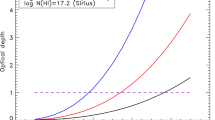Abstract
Binary systems formed by early-type stars with strong winds are known to display variable non-thermal radio emission, thermal X-rays, and, at least in one case (Eta Carina), γ rays. Some of these systems are quite eccentric and the conditions for efficient particle acceleration and γ-ray production might manifest only occasionally. In this paper, I briefly review the physics of colliding wind binaries with emphasis on the observational signatures of non-thermal particle acceleration. I discuss, in particular, the case of the system HD 93129A which is made up of an O2 If* star (the primary) and an O3.5 V star (the secondary). The primary is among the earliest, hottest, most massive, luminous, and windy O stars in the Galaxy. The periastron passage during 2018 will offer an outstanding observational window that will be exploited by an international multi-wavelength campaign.


Similar content being viewed by others
Notes
Fermi, being an instrument for surveys, is perhaps not the best option for tracking this event.
References
Balbo M, Walter R (2017) Fermi acceleration along the orbit of \(\eta \) Carinae. A&A 603:A111
Benaglia P, Koribalski B, Albacete Colombo JF (2006) Radio detection of colliding wind binaries. PASA 23:50–63
Benaglia P, Marcote B, Moldón J et al (2015) A radio map of the colliding winds in the very massive binary system HD93129A. A&A 579:A99
Benaglia P (2016) Is the stellar system WR 11 a gamma-ray source? Publ Astron Soc Austr 33:id.e017
Benaglia P, Romero GE (2003) Gamma-ray emission from Wolf–Rayet binaries. A&A 399:1121–1134
Bykov AM (2014) Nonthermal particles and photons in starburst regions and superbubbles. A&ARv 22:id.77
De Becker M (2007) Non-thermal emission processes in massive binaries. A&ARv 14:171–216
De Becker M, Raucq F (2013) Catalogue of particle-accelerating colliding-wind binaries. A&A 558:A28
De Becker M, Benaglia P, Romero GE, Peri CS (2017) An investigation into the fraction of particle accelerators among colliding-wind binaries: Towards an extension of the catalogue. A&A 600:A47
del Palacio S, Bosch-Ramon V, Romero GE, Benaglia P (2016) A model for the non-thermal emission of the very massive colliding-wind binary HD 93129A. A&A 591:A139
Dougherty SM, Beasley AJ, Claussen MJ, Zauderer BA, Bolingbroke NJ (2005) High-resolution radio observations of the colliding-wind binary WR 140. ApJ 623:447–459
Eichler D, Usov V (1993) Particle acceleration and nonthermal radio emission in binaries of early-type stars. ApJ 402:271–279
Pshirkov MS (2016) The Fermi-LAT view of the colliding wind binaries. MNRAS 457:L99–L102
Pittard JM, Dougherty SM (2006) Radio, X-ray, and -ray emission models of the colliding-wind binary WR140. MNRAS 372:801–826
Reimer A, Pohl M, Reimer O (2006) Nonthermal high-energy emission from colliding winds of massive stars. ApJ 644:1118–1144
Reitberger K, Reimer O, Reimer A et al (2012) Gamma-ray follow-up studies on \(\eta \) Carinae. A&A 544:A98
Reitberger K, Kissmann R, Reimer A, Reimer O (2014) Simulating three-dimensional nonthermal high-energy photon emission in colliding-wind binaries. ApJ 789:id.87
Schure KM, Bell AR, O’C Drury L, Bykov AM (2012) Diffusive shock acceleration and magnetic field amplification. Space Sci Rev 173:491–519
Tavani M, Sabatini S, Pian E et al (2009) Detection of gamma-ray emission from the Eta-Carinae region. ApJ 698:L142–L146
Acknowledgements
I thank S. del Palacio, V. Bosch Ramon, P. Benaglia, and M. De Becker for many discussions on this topic. My work was supported by the Helmholtz Association through a Helmholtz International Fellow Award. Additional support was provided by the Argentine agency CONICET (PIP 2014-00338) and the Spanish Ministerio de Economía y Competitividad (MINECO/FEDER, UE) under grant AYA2016-76012-C3-1-P.
Author information
Authors and Affiliations
Corresponding author
Additional information
Publisher's Note
Springer Nature remains neutral with regard to jurisdictional claims in published maps and institutional affiliations.
This paper is the peer-reviewed version of a contribution selected among those presented at the Conference on Gamma-Ray Astrophysics with the AGILE Satellite held at Accademia Nazionale dei Lincei and Agenzia Spaziale Italiana, Rome on December 11–13, 2017.
Rights and permissions
About this article
Cite this article
Romero, G.E. Gamma rays from colliding winds in massive binaries. Rend. Fis. Acc. Lincei 30 (Suppl 1), 115–118 (2019). https://doi.org/10.1007/s12210-019-00763-2
Received:
Accepted:
Published:
Issue Date:
DOI: https://doi.org/10.1007/s12210-019-00763-2
Keywords
- Emission-line stars (Of
- Be
- Luminous Blue Variables
- Wolf–Rayet
- etc.)
- γ-Ray sources
- Mass loss and stellar winds
- Radiation mechanisms




